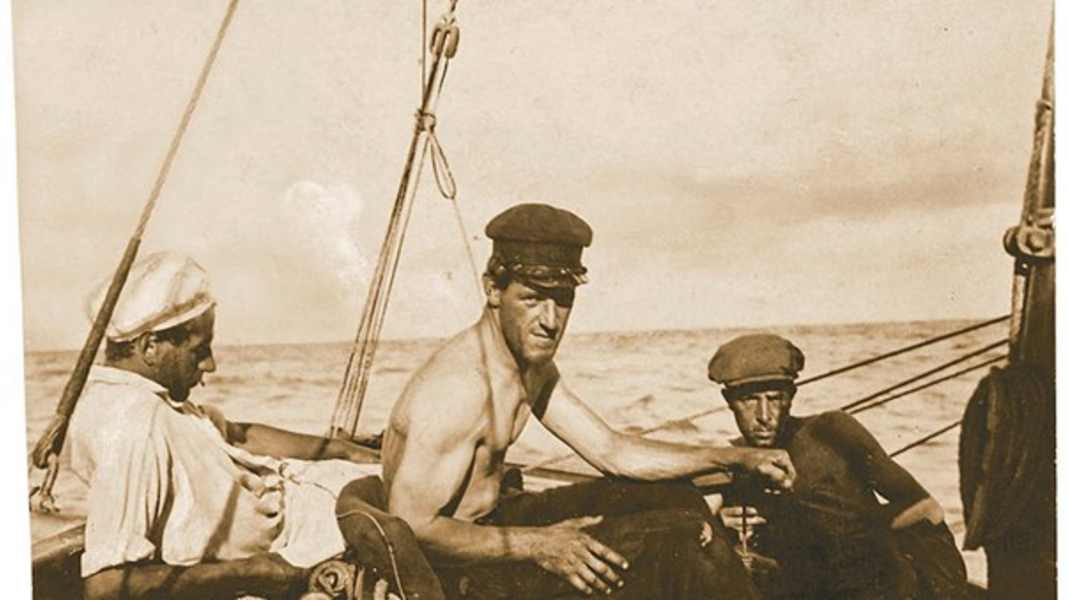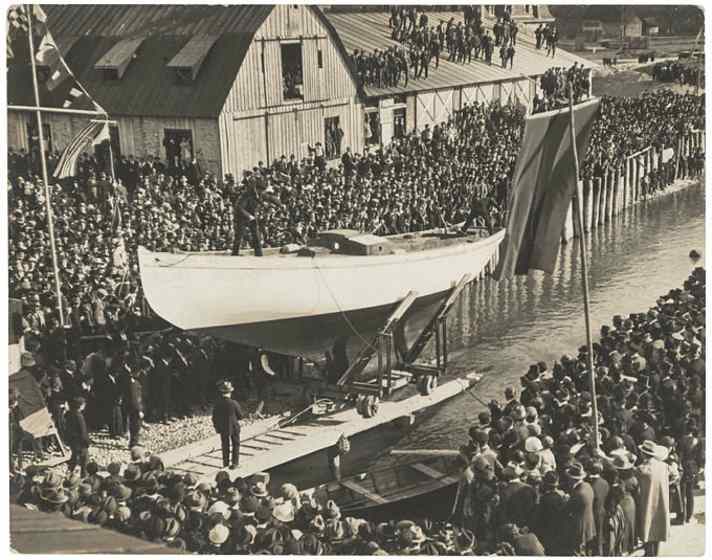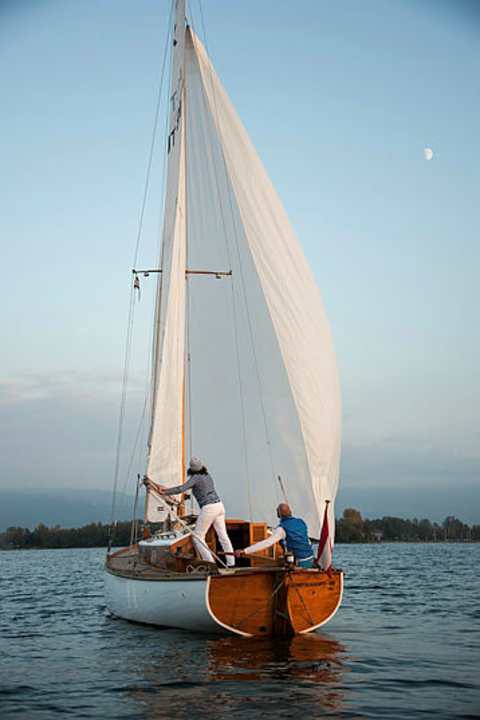Exhibition: The adventurous life of the Atlantic conqueror and boat designer Franz Plunder

The Atlantic crossing with the "Sowitasgoht V"
Few believed in the success of the project when the masterpiece of designer Franz Plunder was launched in Hard on Lake Constance on 1 April 1923: The 14 metre long and 3 metre wide "Sowitasgoht V". The name "As far as it goes" was the programme - it was actually going to reach America. Around 12,000 people gathered to marvel at the four adventurers setting off on their journey from Hamburg to New York. "Let's take another look at these guys, they're drowning after all," whispered one spectator. For the crew, these were distant concerns, more obvious was the simple need to survive: everyone was completely broke. "It was frightening to see how our boat had lost its appetite, we had nothing, absolutely nothing left, but one thing was good, we were well trained for all the hardships that were to come," said Plunder.
Hardships awaited them more than expected, and doubts may have arisen as they floundered between Madeira and the longed-for America. "We knew and felt that people were thinking a lot about us and that perhaps many were saying 'they've already been done for'," Plunder later wrote in a travelogue. But the crew showed perseverance. Despite running out of water and dwindling potato supplies, they overcame the challenges. After 5,800 nautical miles and 61 days on the high seas, the four Atlantic crossers docked in New York harbour on 13 September 1923. They made history as the first German and Austrian sports sailors to cross the Atlantic together in an east-west direction.

Pioneering achievement with obstacles
The preparation and realisation of the Atlantic crossing was characterised by numerous obstacles. Plunder and his team not only had to overcome technical challenges, but also financial bottlenecks. They launched one of the first sponsorship campaigns in German and Austrian sailing history to finance their endeavour. Despite initial scepticism, inflation and bureaucratic hurdles, they managed to realise the project. Nevertheless: "It is a very, very difficult thing to travel without money, especially with a yacht," Plunder realised when they lost the anchor chain just one day after leaving Hamburg - just one of many challenges that the Austrian-German quartet had to overcome. The exhibition at the vorarlberg museum sheds light on these aspects and shows how Plunder and his crew realised their dreams through perseverance and a spirit of innovation.
Plunder's legacy
Born in Bregenz in 1891, the sculptor and yacht designer was already building model boats as a child. In 1904, he built a rowing boat, which Plunder later fitted with a sail. Around 1910, he finally built a seven-metre sailing boat.
However, after the young Plunder had to leave grammar school after four years due to an "unspecified stupidity", he attended the Imperial and Royal Technical College for Industrial Drawing and later the Academy of Fine Arts in Vienna due to his talent. He became a sculptor - and remained true to his dreams: sailing, boats and America, the country where he would later make his home for many years. Throughout his life, Plunder wandered between disciplines and continents, and his career as a boat builder was correspondingly erratic. It was based exclusively on an internship at a shipyard in Hamburg lasting several weeks, a great deal of inspiration, self-taught learning and a spirit of adventure.
"Sowitasgoht V" makes Plunder famous
It is not known exactly when it began. However, Plunder sold his first "Sowitasgoht" before the First World War, and nine more were to follow. Number five made him famous and is considered to be one of the first yachts to sail across the Atlantic without a gaff rig. The only thing his yachts had in common was the name. They were between six and 14 metres long, with a centreboard or fixed keel, designed for inland waterways or the high seas.
Plunder built the "Sowitasgoht VI" with Ernst Burmester in Bremen in the middle of the global economic crisis. He sailed with her to the Adriatic and Aegean. The "Sowitasgoht VII" followed in the 1930s and is still at home in Hard on Lake Constance today. The "Porcupine II" designed by Plunder, also built by Ernst Burmester in Bremen, is still moored on the Swiss shore of Lake Constance in Aarborn. Plunder's last own boat, "Sowitasgoht X", was launched in 1961. He sailed it until shortly before his death in 1974.
The name became his trademark, even though he built countless other boats. The commercial peak of Franz Plunder's boatbuilding career began immediately after the First World War with the founding of the "Plunder Werft" shipyard in Bregenz, with a well-heeled clientele in neighbouring Switzerland with its stable currency. Just one year after it was founded, it had 30 employees and boats in the 7 to 8 metre class were literally rolling off the production line. When the space in Bregenz became too small, the shipyard moved to Hard and also built larger sea cruisers. Plunder's cracks are characterised by sturdy reliability rather than elegance, and no two boats were the same. Seven of Plunder's ships alone took part in the 1921 Lake Constance Week.
"Plunder Werft" becomes the "Bodensee Werft" with Ferdinand Porsche
In the same year, Ferdinand Porsche also had a 45 built according to Plunder's plans - and joined the shipyard business. The "Plunder Werft" became the "Bodensee Werft" and from then on also built motorboats. "It had become a big shipyard, but I didn't like it any more. It almost came to blows between me and the general manager Porsche. Shortly afterwards, I decided to leave G.m.b.H.," says Plunder, describing his move from successful shipyard owner to adventurer, who was to sail to America the following year.

In addition to the few surviving boats from Plunder's pen, ten rolls of construction plans still bear witness to his lively boatbuilding endeavours. His neighbour at the time, the now 84-year-old Wolfgang Allgeuer from the Yacht Club Bregenz, saved them from destruction after Plunder's death in 1974 and handed them over to the city archives. Plunder's autobiography with the obvious title "Sowitasgoht" is now only available in antiquarian bookshops. However, as the curator of the Vorarlberg Museum, Markus Barney, has discovered, it oscillates between fiction and truth. In the Museum television is an entertaining talk by Barney about the life of Franz Plunder.
Exhibition shows multifaceted personality
The special exhibition at the vorarlberg museum presents Franz Plunder as a multifaceted personality. Three illuminated ship's masts in the first exhibition room provide insights into his childhood, his work as a sculptor and his time in America. Even the red-white-red flag that was attached to the stern of the "Sowitasgoht V" has been preserved. Especially for the exhibition, the Model builder Jürgen Oltmann from Schwanewede/Bremen, who was recently featured in YACHT, A 1:10 scale model of the "Sowitasgoht V", which is true to the original and invites visitors to explore many details. In an experience room, visitors can experience metre-high waves on screens and listen to a radio play about the hardships of crossing the Atlantic. The third part of the exhibition is dedicated to the life of Franz Plunder: various boxes invite visitors to explore the stories in the history and awaken their own thirst for adventure. A large table offers space to spread out the boxes and discover the fascinating details of Plunder's life.
The vorarlberg museum in Bregenz will be showing the exhibition from April 2025 to autumn 2026 every Tuesday to Sunday from 10.00 to 18.00, and every 1st Thursday from 10.00 to 20.00.

